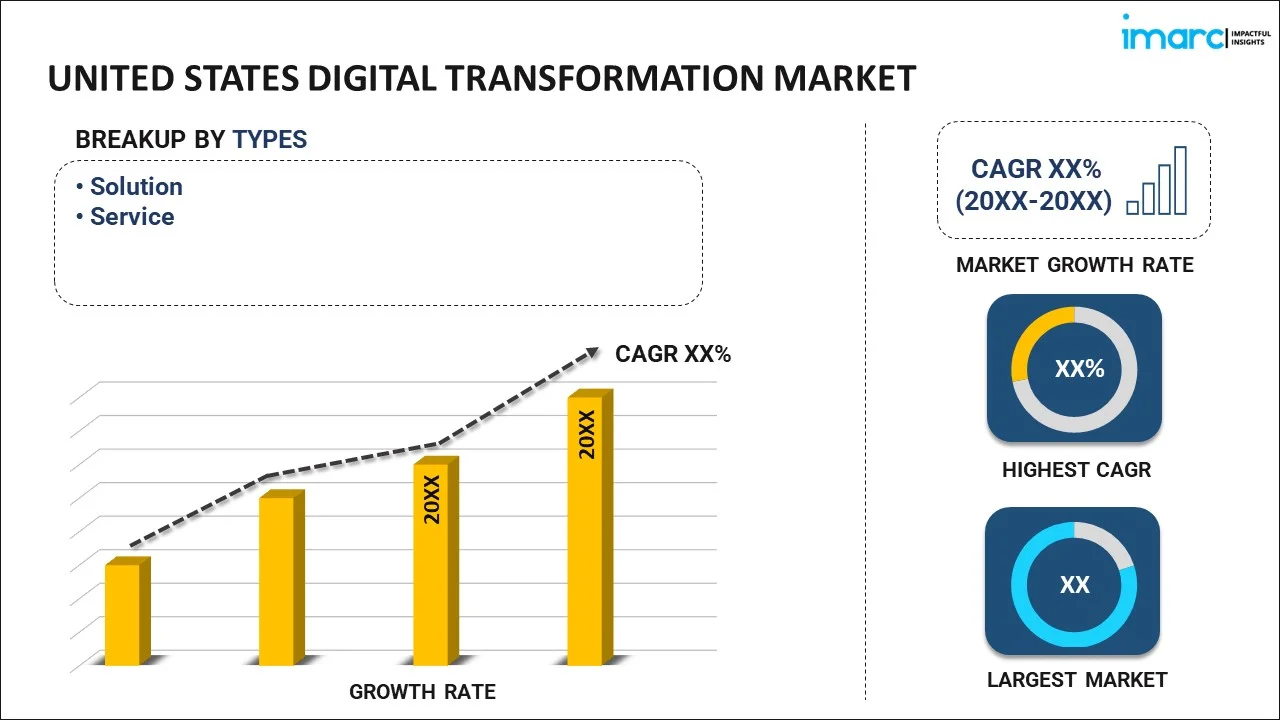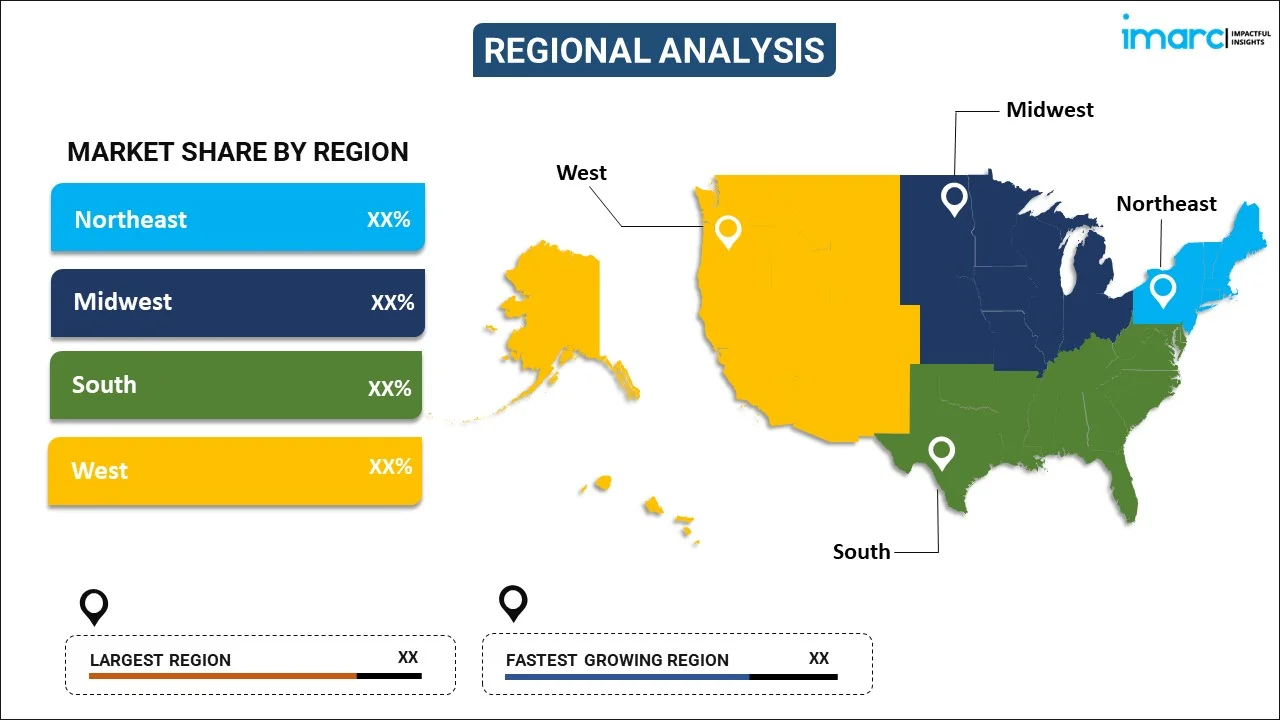
United States Digital Transformation Market Report by Type (Solution, Service), Deployment Mode (Cloud-based, On-premises), Enterprise Size (Large Enterprises, Small and Medium-sized Enterprises), End Use Industry (BFSI, Manufacturing and Retail, Government, Healthcare, IT and Telecom, and Others), and Region 2025-2033
United States Digital Transformation Market Size, Share & Analysis:
The United States digital transformation market size reached USD 210.4 Billion in 2024. Looking forward, IMARC Group expects the market to reach USD 1,375.5 Billion by 2033, exhibiting a growth rate (CAGR) of 21.6% during 2025-2033. The growing adoption of remote and flexible work practices in organizations, rising demand for seamless and intuitive digital experiences among individuals, and the increasing emphasis on data-driven decision-making in different businesses represent some of the key factors driving the market.
|
Report Attribute
|
Key Statistics
|
|---|---|
|
Base Year
|
2024
|
|
Forecast Years
|
2025-2033
|
|
Historical Years
|
2019-2024
|
|
Market Size in 2024
|
USD 210.4 Billion |
|
Market Forecast in 2033
|
USD 1,375.5 Billion |
| Market Growth Rate 2025-2033 | 21.6% |
United States Digital Transformation Market Insights:
- Major Market Drivers: Increasing demand for operational efficiency, higher adoption of cloud, and growing applications of AI and automation are major drivers driving United States digital transformation market share, as companies upgrade infrastructure to compete and keep up with changing customer expectations.
- Key Market Trends: Cloud-first strategies, decision-making powered by AI, and IoT enablement are driving market trends toward strong adoption of agile business models, real-time data use, and digital-first customer interactions across sectors.
- Competitive Landscape: The United States digital transformation market size is marked by fierce competition between technology companies, system integrators, and cloud platforms due to the demand for scalable, secure, and tailored solutions to fuel innovation, cost savings, and digital maturity among businesses.
- Challenges and Opportunities: Challenges encompass integration of legacy systems and data security, while opportunities are represented by AI innovation, edge computing, and 5G deployment. These drivers present opportunities for nimble firms to dominate the next wave of digital modernization in the U.S. market.
United States Digital Transformation Market Trends:
Cloud-First Strategies Adoption Across Industries
One important trend that has dominated the United States digital transformation landscape is the broad adoption of cloud-first strategies in public as well as private sector industries. Organizations are more and more focusing on cloud-native applications, hybrid cloud environments, and infrastructure-as-a-service (IaaS) models to achieve scalability, operational elasticity, and data access. Cloud platforms support real-time analysis, spontaneous remote collaboration, and streamlined integration of enterprise systems, making them at the heart of transformation initiatives. This transition has resulted in increased focus on interoperability, resilience, and data-driven decision-making. The healthcare, finance, and manufacturing industries, in particular, are using cloud infrastructure to transform legacy systems and provide business continuity. Enterprise clouds continue to mature, and enterprises are deploying containerization and orchestration tools to enable dynamic workloads. The United States Digital Transformation Market Size continues to grow with these changes, driving long-term modernization and digital integration, with cloud computing being a bedrock tenet of United States digital transformation market trends.
Growth of Artificial Intelligence and Automation in Business Operations
Artificial intelligence (AI) and automation technologies are transforming enterprise functions and service delivery in the United States. From robotic process automation (RPA) to machine learning (ML) and natural language processing (NLP), AI is helping organizations simplify processes, eliminate redundancies, and tailor customer experiences. AI-powered solutions are being widely used in supply chain optimization, anti-fraud initiatives, IT operations, and smart virtual assistance. This transformation not only enables efficiency but also the ability to derive strategic insights from volumes of data. Automation software also helps ensure compliance, consistency, and productivity within departments. With organizations embracing AI as a part of their digital infrastructure, the need for talent and AI governance models is also increasing. This is driving United States digital transformation market growth, creating an ecosystem where AI technologies are at the center of value creation, decision-making, and future competitiveness in the market analysis.
Integration of Internet of Things (IoT) for Intelligent Infrastructure
The spread of Internet of Things (IoT) devices is playing a central role in driving digital transformation activities across sectors in the United States. From connected healthcare systems and smart manufacturing to urban mobility and energy management, IoT integration is creating greater visibility into operations and empowering predictive intelligence. Sensors and embedded systems are increasingly being used to collect real-time information, track equipment performance, and aid condition-based maintenance. This integration enables the development of intelligent ecosystems that are adaptive, efficient, and responsive to dynamic conditions. Also, increasing adoption of digital twins and edge computing is making IoT an enhancer for the speed of automation as well as response time. As per the sources, in July 2024, immersive technology firm Cosm raised more than \\$250 million in a strategic funding round to expand its global experiential entertainment destinations, develop technology offerings, and build media operations. Moreover, as organizations and cities go for these technologies, the market share keeps growing, highlighting the core position of IoT in digitally enabled infrastructure as well as services. These developments are symptomatic of a wider trend in the United States digital transformation market trends, with an emphasis on connectivity as well as intelligent systems.
United States Digital Transformation Market Segmentation:
IMARC Group provides an analysis of the key trends in each segment of the United States digital transformation market report, along with forecasts at the country level for 2025-2033. Our report has categorized the market based on type, deployment mode, enterprise size, and end use industry.
Type Insights:

To get more information on this market, Request Sample
- Solution
- Analytics
- Cloud Computing
- Mobility
- Social Media
- Others
- Service
- Professional Services
- Integration and Implementation
The report has provided a detailed breakup and analysis of the market based on the type. This includes solution (analytics, cloud computing, mobility, social media, and others) and service (professional services and integration and implementation).
Deployment Mode Insights:
- Cloud-based
- On-premises
A detailed breakup and analysis of the market based on the deployment mode has also been provided in the report. This includes cloud-based and on-premises.
Enterprise Size Insights:
- Large Enterprises
- Small and Medium-sized Enterprises
A detailed breakup and analysis of the market based on the enterprise size has also been provided in the report. This includes large enterprises and small and medium-sized enterprises.
End Use Industry Insights:
- BFSI
- Manufacturing and Retail
- Government
- Healthcare
- IT and Telecom
- Others
A detailed breakup and analysis of the market based on the end use industry has also been provided in the report. This includes BFSI, manufacturing and retail, government, healthcare, IT and telecom, and others.
Regional Insights:

- Northeast
- Midwest
- South
- West
The report has also provided a comprehensive analysis of all the major regional markets, which include Northeast, Midwest, South, and West.
Competitive Landscape:
The report has also provided a comprehensive analysis of the competitive landscape in the United States digital transformation market. Competitive analysis such as market structure, key player positioning, top winning strategies, competitive dashboard, and company evaluation quadrant has been covered in the report. Also, detailed profiles of all major companies have been provided.
Latest News and Developments:
- In May 2024, SolarWinds introduced SolarWinds® AI, a generative AI platform built under its new AI by Design philosophy. Embedded in SolarWinds Service Desk, it further improves IT service management by speeding up the resolution of tickets, enhancing service delivery, and providing secure, transparent, and efficient operations for digital transformation projects.
- In April 2024, Microsoft and Cloud Software Group formed an eight-year strategic relationship to accelerate cloud adoption and generative AI innovation. With a \\$1.65 billion investment in Microsoft Cloud, the deal reinforces Citrix as the go-to Azure partner, with a goal to serve more than 100 million users via integrated digital offerings.
United States Digital Transformation Report Coverage:
| Report Features | Details |
|---|---|
| Base Year of the Analysis | 2024 |
| Historical Period | 2019-2024 |
| Forecast Period | 2025-2033 |
| Units | Billion USD |
| Scope of the Report | Exploration of Historical and Forecast Trends, Industry Catalysts and Challenges, Segment-Wise Historical and Predictive Market Assessment:
|
| Types Covered |
|
| Deployment Modes Covered | Cloud-Based, On-Premises |
| Enterprise Sizes Covered | Large Enterprises, Small and Medium-Sized Enterprises |
| End Use Industries Covered | BFSI, Manufacturing and Retail, Government, Healthcare, IT And Telecom, Others |
| Regions Covered | Northeast, Midwest, South, and West |
| Customization Scope | 10% Free Customization |
| Post-Sale Analyst Support | 10-12 Weeks |
| Delivery Format | PDF and Excel through Email (We can also provide the editable version of the report in PPT/Word format on special request) |
Key Benefits for Stakeholders:
- IMARC’s report offers a comprehensive quantitative analysis of various market segments, historical and current market trends, market forecasts, and dynamics of the United States digital transformation market from 2019-2033.
- The research study provides the latest information on the market drivers, challenges, and opportunities in the United States digital transformation market.
- Porter's five forces analysis assist stakeholders in assessing the impact of new entrants, competitive rivalry, supplier power, buyer power, and the threat of substitution. It helps stakeholders to analyze the level of competition within the United States digital transformation industry and its attractiveness.
- Competitive landscape allows stakeholders to understand their competitive environment and provides an insight into the current positions of key players in the market.
Key Questions Answered in This Report
The digital transformation market in the United States was valued at USD 210.4 Billion in 2024.
The United States digital transformation market is projected to exhibit a CAGR of 21.6% during 2025-2033, reaching a value of USD 1,375.5 Billion by 2033.
Some of the key drivers of the United States digital transformation market are rising demand for cloud computing, expanding use of AI and automation, and the necessity for improved customer experience. In addition to this, the growth in IoT-enabled infrastructure, increased spending on data analytics, and changing regulatory compliance needs are compelling businesses to transform operations, enhance flexibility, and stay ahead in a digitally interconnected world.
Need more help?
- Speak to our experienced analysts for insights on the current market scenarios.
- Include additional segments and countries to customize the report as per your requirement.
- Gain an unparalleled competitive advantage in your domain by understanding how to utilize the report and positively impacting your operations and revenue.
- For further assistance, please connect with our analysts.
 Request Customization
Request Customization
 Speak to an Analyst
Speak to an Analyst
 Request Brochure
Request Brochure
 Inquire Before Buying
Inquire Before Buying




.webp)




.webp)












